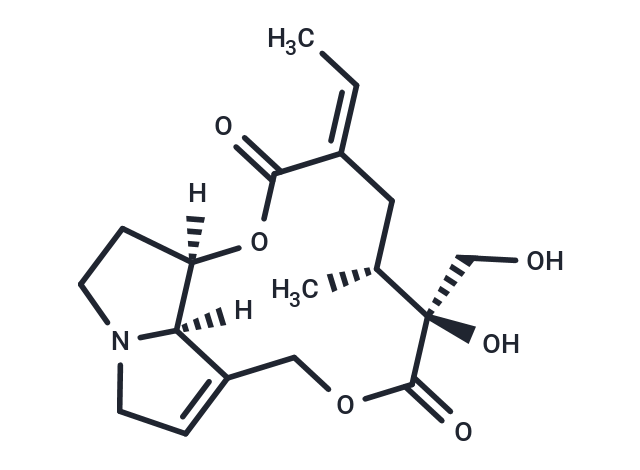Shopping Cart
Remove All Your shopping cart is currently empty
Your shopping cart is currently empty
Retrorsine selectively inhibits hepatocyte proliferation and following liver injury evokes small hepatocyte-like progenitor cells. Retrorsine can be used for the research of hepatocellular injury.

| Pack Size | Price | USA Warehouse | Global Warehouse | Quantity |
|---|---|---|---|---|
| 1 mg | $127 | 7-10 days | 7-10 days | |
| 5 mg | $268 | 7-10 days | 7-10 days |
| Description | Retrorsine selectively inhibits hepatocyte proliferation and following liver injury evokes small hepatocyte-like progenitor cells. Retrorsine can be used for the research of hepatocellular injury. |
| Targets&IC50 | OCT1:2.2 μM |
| In vitro | Retrorsine inhibited the OCT1-mediated 1-methyl-4-phenylpyridinium (MPP(+)) uptake in MDCK-hOCT1 cells with the IC50 of 2.25±0.30μM[1]. Retrorsine (60 μM, 120 μM , 240 μM; 24 h) significantly reduced HSEC-CYP3A4 cell viability and GSH levels and increases the formation of pyrrole-protein adducts[2]. |
| In vivo | In male Wistar rats, Retrorsine (30 mg/kg; i.p.; twice) impaired liver regeneration in the PBL model not only by an S or G2/M phase block but also by a block located before the G1/S transition of the cell cycle[3]. |
| Molecular Weight | 351.39 |
| Formula | C18H25NO6 |
| Cas No. | 480-54-6 |
| Smiles | [H][C@]12CCN3CC=C(COC(=O)[C@@](O)(CO)[C@H](C)C\C(=C\C)C(=O)O1)[C@]23[H] |
| Relative Density. | 1.328g/cm3 |
| Storage | keep away from direct sunlight,keep away from moisture,store at low temperature | Powder: -20°C for 3 years | In solvent: -80°C for 1 year | Shipping with blue ice/Shipping at ambient temperature. | |||||||||||||||||||||||||||||||||||
| Solubility Information | DMSO: 95 mg/mL (270.35 mM), Sonication is recommended. | |||||||||||||||||||||||||||||||||||
| In Vivo Formulation | 10% DMSO+40% PEG300+5% Tween-80+45% Saline: 3.3 mg/mL (9.39 mM), Sonication is recommeded. Please add the solvents sequentially, clarifying the solution as much as possible before adding the next one. Dissolve by heating and/or sonication if necessary. Working solution is recommended to be prepared and used immediately. The formulation provided above is for reference purposes only. In vivo formulations may vary and should be modified based on specific experimental conditions. | |||||||||||||||||||||||||||||||||||
Solution Preparation Table | ||||||||||||||||||||||||||||||||||||
DMSO
| ||||||||||||||||||||||||||||||||||||
| Size | Quantity | Unit Price | Amount | Operation |
|---|

Copyright © 2015-2025 TargetMol Chemicals Inc. All Rights Reserved.